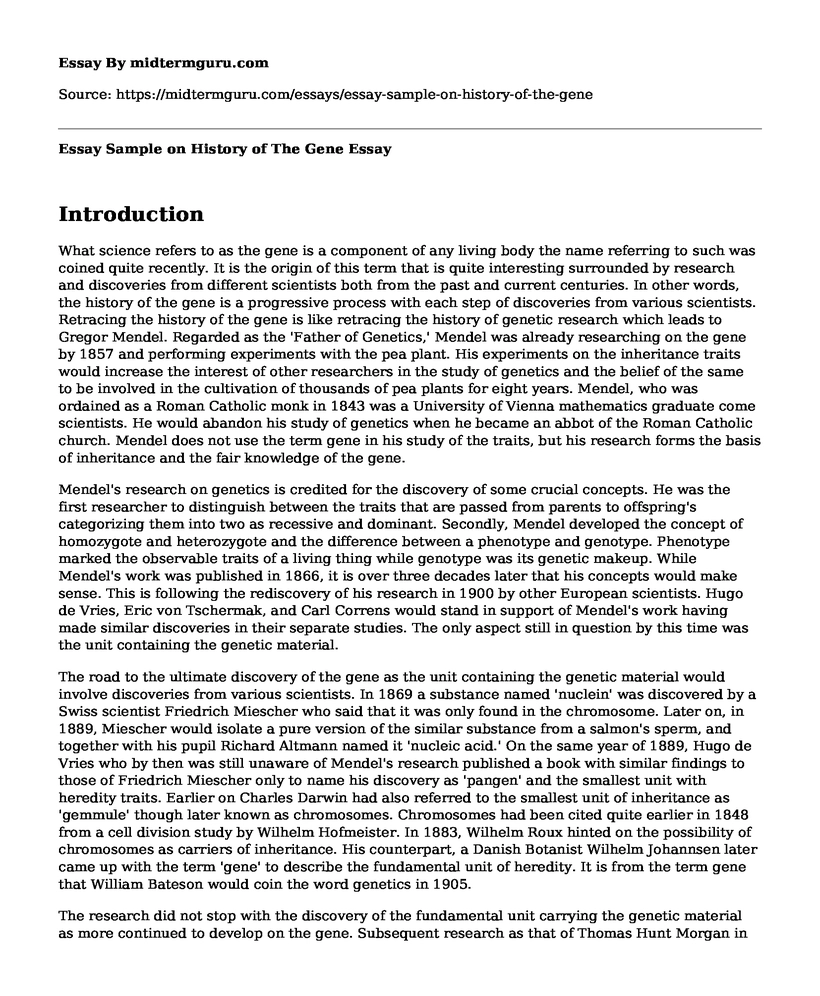Introduction
What science refers to as the gene is a component of any living body the name referring to such was coined quite recently. It is the origin of this term that is quite interesting surrounded by research and discoveries from different scientists both from the past and current centuries. In other words, the history of the gene is a progressive process with each step of discoveries from various scientists. Retracing the history of the gene is like retracing the history of genetic research which leads to Gregor Mendel. Regarded as the 'Father of Genetics,' Mendel was already researching on the gene by 1857 and performing experiments with the pea plant. His experiments on the inheritance traits would increase the interest of other researchers in the study of genetics and the belief of the same to be involved in the cultivation of thousands of pea plants for eight years. Mendel, who was ordained as a Roman Catholic monk in 1843 was a University of Vienna mathematics graduate come scientists. He would abandon his study of genetics when he became an abbot of the Roman Catholic church. Mendel does not use the term gene in his study of the traits, but his research forms the basis of inheritance and the fair knowledge of the gene.
Mendel's research on genetics is credited for the discovery of some crucial concepts. He was the first researcher to distinguish between the traits that are passed from parents to offspring's categorizing them into two as recessive and dominant. Secondly, Mendel developed the concept of homozygote and heterozygote and the difference between a phenotype and genotype. Phenotype marked the observable traits of a living thing while genotype was its genetic makeup. While Mendel's work was published in 1866, it is over three decades later that his concepts would make sense. This is following the rediscovery of his research in 1900 by other European scientists. Hugo de Vries, Eric von Tschermak, and Carl Correns would stand in support of Mendel's work having made similar discoveries in their separate studies. The only aspect still in question by this time was the unit containing the genetic material.
The road to the ultimate discovery of the gene as the unit containing the genetic material would involve discoveries from various scientists. In 1869 a substance named 'nuclein' was discovered by a Swiss scientist Friedrich Miescher who said that it was only found in the chromosome. Later on, in 1889, Miescher would isolate a pure version of the similar substance from a salmon's sperm, and together with his pupil Richard Altmann named it 'nucleic acid.' On the same year of 1889, Hugo de Vries who by then was still unaware of Mendel's research published a book with similar findings to those of Friedrich Miescher only to name his discovery as 'pangen' and the smallest unit with heredity traits. Earlier on Charles Darwin had also referred to the smallest unit of inheritance as 'gemmule' though later known as chromosomes. Chromosomes had been cited quite earlier in 1848 from a cell division study by Wilhelm Hofmeister. In 1883, Wilhelm Roux hinted on the possibility of chromosomes as carriers of inheritance. His counterpart, a Danish Botanist Wilhelm Johannsen later came up with the term 'gene' to describe the fundamental unit of heredity. It is from the term gene that William Bateson would coin the word genetics in 1905.
The research did not stop with the discovery of the fundamental unit carrying the genetic material as more continued to develop on the gene. Subsequent research as that of Thomas Hunt Morgan in 1910 proved the existence of genes within particular chromosomes. Morgan and his pupils would use a fruit fly to develop the first chromosol map. In another case, Frederick Griffith in 1928 established the basis of DNA as the molecule of inheritance transferrable from parents to their offspring. In 1941, the 'one gene' hypothesis would be coined by Edward Lawrie Tatum and George Wells Beadle to prove genetic mutation as causing errors in specific steps in metabolic pathways. Later on, in 1953, researchers Francis Crick and James Watson while attempting to create a model DNA would discover the double helix structure. In 1972, Walter Fiers and his fellow researchers from the University of Ghent in Belgium discovered the sequencing of genes from a bacteriophage MS2 coat protein. In the light of this knowledge, Phillip Sharp and Richard Roberts discovered the possibility to split genes into segments for coding to several proteins. The sequencing of the gene formed the basis for the late nineties and post-millennium discovery that the proteins within a gene can overlap and are a characteristically long continuum. This discovery would reveal that somehow few genes can encode all the proteins in a living thing. The protein coding sequence is 1-2 percent of the genome make up. Ultimately, each discovered gene would be named and given a symbol as per the recommendations and guidelines offered by the HUGO Gene Nomenclature Committee. Such symbols and names are applicable modernly...
Cite this page
Essay Sample on History of The Gene. (2022, Oct 04). Retrieved from https://midtermguru.com/essays/essay-sample-on-history-of-the-gene
If you are the original author of this essay and no longer wish to have it published on the midtermguru.com website, please click below to request its removal:
- Essay Sample: Wisdom From a Rainforest
- Paper Example on Organic Chemistry and Its Differences from Other Branches of Chemistry
- Essay Sample on Organic Chemistry
- Essay Sample on Mathematics an History as an Area of Knowledge
- Children's Sensory Exploration: Enhancing Brain Development Through Play - Research Paper
- Brain Injury: Altering My Mental State and Cognitive Abilities - Essay Sample
- Unlocking the Wonders of Medical Science: My Passionate Journey - Essay Sample







